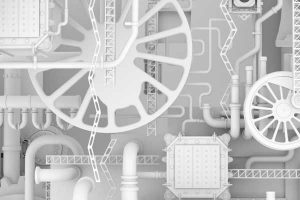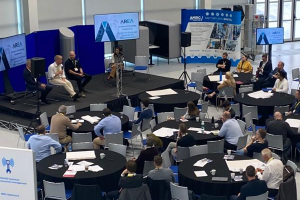Transforming the Industrial Metaverse with Augmented Reality Technology

You may have heard about the industrial metaverse lately in the news or event at recent events. This immersive and interactive world combines real and virtual elements to create a new, innovative form of collaboration and production along with many other evolving uses. This digital environment is rapidly changing how we work, learn, and play, and augmented reality (AR) plays a crucial role in its development and success.
AR is a technology that superimposes digital information onto the physical world, creating a new and interactive experience. AR revolutionizes the industrial metaverse by allowing users to visualize and control digital models for improved enterprise design, production, and maintenance.
“The metaverse brings the physical and digital worlds together, allowing people and things to collaborate more intuitively with complex systems in person or afar,” explains Steve Dertien, Chief Technology Officer of PTC. “The metaverse, as a 3D interface for IoT, will make the physical and digital indistinguishable and therefore augment our human ability to make better-informed decisions with a minimum of mental energy and training.”
One of the critical benefits of AR in the industrial metaverse is that it reimagines remote collaboration and knowledge transfer. By combining natural and virtual elements, AR can create a shared experience between experts in different locations, allowing them to work together on complex projects and problems in real-time. This can help reduce the time and cost associated with traditional collaboration methods, such as travel, while also improving the quality and accuracy of the results.
Another essential benefit of AR in the industrial metaverse is that it can help to reduce the risk of human error and improve safety in high-risk industrial environments. For example, AR can provide workers with real-time information and guidance, reducing the need for manual processes and minimizing the risk of accidents and errors.
The AREA recognizes that human-centered design is critical to building and deploying successful AR applications, devices, and services. The Human Factors Committee is a forum for members to exchange ideas, resources, and research on best practices. The AREA-funded research on Safety and Human Factors Assessment Framework and Best Practice Report reviews the general risk management cycle as a preface to describing a new ‘Safe AR Design – Best Practice’ methodology for enterprise AR. Check out the case study and report here.
In addition, AR can also help to improve the efficiency and productivity of industrial operations. By providing workers with real-time information and feedback, AR can help to optimize processes and increase the speed and accuracy of decision-making. This can help to reduce downtime, increase output, and improve overall performance.
To fully realize the benefits of AR in the industrial metaverse, it is vital to have the proper infrastructure in place, depending on the use case. By investing in the right technology and tools, companies can create a new and innovative industrial environment optimized for collaboration, production, and efficiency. One example of this is remote assistance. Whether you are working on adopting AR or a provider, the AREA’s member ecosystem works together to help accelerate enterprise adoption across industries.
In conclusion, AR plays a critical role in developing the industrial metaverse, providing companies with a new and powerful tool for collaboration, knowledge transfer, and production. With the right technology and infrastructure in place, AR can help companies revolutionize how they work and compete, creating a new, innovative form of digital collaboration optimized for a safe and productive future.

